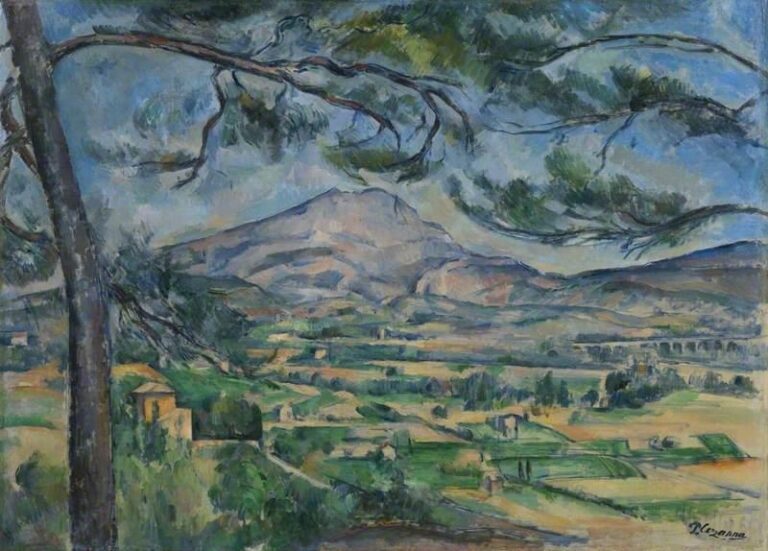In a bold move to capitalize on its artistic heritage, the French city of Aix-en-Provence has secured trademark rights to the name “Cézanne,” in a bid to honor the legacy of one of its most illustrious residents, painter Paul Cézanne. Recognized as a pivotal figure in the transition to modern art, Cézanne’s contributions have left an indelible mark on the artistic landscape. This trademark initiative is not just about preserving the name; it is a strategic effort to promote tourism, celebrate local culture, and broaden economic opportunities tied to the artist’s enduring influence. As cities around the world increasingly leverage their historical figures for economic gain, Aix-en-Provence’s trademark decision raises questions about the intersection of art, commerce, and cultural identity.
French City Capitalizes on Cézanne’s Legacy to Drive Tourism Revenue
The vibrant city of Aix-en-Provence is embracing its rich artistic heritage by trademarking the name of renowned painter Paul Cézanne, often hailed as the father of modern art. By doing so, the city aims to create a distinctive brand that will attract art enthusiasts and tourists alike, hoping to transform its cultural assets into a thriving economic engine. The initiative not only seeks to enhance the city’s visibility on the global stage but also to establish a sustainable tourism model centered around Cézanne’s profound influence on contemporary art.
To bolster this endeavor, city officials plan to organize a variety of events and exhibitions that highlight Cézanne’s life and work, appealing to both seasoned art lovers and curious newcomers. These may include:
- Art walks through Cézanne’s favorite landscapes
- Workshops that imitate his techniques
- Special exhibitions showcasing his most famous pieces
Through these initiatives, Aix-en-Provence aspires to not only promote tourism but also to foster a deeper appreciation of its cultural legacy. A recent study suggests that cultural tourism can significantly impact local economies, and the city hopes to capitalize on this trend, ensuring that Cézanne’s influence continues to inspire generations to come.
Legal Implications of Trademarking Artistic Names in France
The decision to trademark the name “Cézanne” by the city of Aix-en-Provence raises several important legal considerations. Under French law, a trademark must fulfill specific criteria to be registered, including distinctiveness and non-descriptiveness. The name “Cézanne,” deeply associated with the city’s artistic heritage, offers a unique case where the trademark serves both an economic purpose and a cultural one. However, the application of trademark law in this scenario also warrants scrutiny regarding the potential dilution of artistic legacy. Artists’ names, particularly those as internationally renowned as Paul Cézanne, navigate a delicate balance between commercial use and maintaining the integrity of their artistic contributions.
Moreover, the implications of such trademarking extend to various stakeholders, including local businesses, artists, and the broader cultural community. The following considerations emerge:
- Ownership Rights: Who ultimately holds rights to the name, and for what purposes can it be used?
- Potential Litigation: The trademark could provoke disputes over unauthorized usages, potentially stifling local artistic expression.
- Cultural Heritage: The trademark may foster a commercialization of the city’s cultural heritage, challenging artists’ ability to freely engage with Cézanne’s legacy.
Balancing Heritage and Commercialization: The Ethical Debate
The recent decision by a French city to trademark the name ‘Cézanne’ has ignited a multifaceted ethical debate regarding the fine line between preserving cultural heritage and generating revenue. On one hand, supporters argue that such a move can lead to increased tourism and funding for local art initiatives, creating a sustainable model for supporting the city’s historical legacy. They believe that prioritizing economics can ultimately enhance the outreach of Cézanne’s work to new audiences. However, critics warn that commercialization could commodify the essence of the artist’s legacy, reducing a profound cultural figure to mere marketing fodder.
Amid this discourse, several key points emerge that highlight the complexities of this issue:
- Impact on Art Community: Some fear that commercialization may overshadow genuine artistic appreciation, prioritizing profit over authenticity.
- Ethical Considerations: Questions arise about who truly holds the rights to a cultural icon’s name and legacy, complicating issues of ownership and respect.
- Tourism vs. Tradition: Balancing the influx of tourists with the preservation of local culture poses a significant challenge for city planners.
As cities grapple with these decisions, the consequences of trademarking cultural icons can be profound. The implications stretch beyond economic interests, touching on the very core of how art and history are valued in society. A comparison of perspectives on this issue can help shed light on the broader implications:
| Perspective | Support | Opposition |
|---|---|---|
| Economic Growth | Tourism boost; funding for local projects | Commodification of heritage; artist’s essence lost |
| Community Impact | Job creation; community pride | Potential cultural dilution; preservation concerns |
| Legal Aspects | Clear rights to protect cultural assets | Ethical ownership disputes; legacy exploitation |
Strategies for Sustaining Local Art Communities Amid Commercial Gains
The trademarking of the name ‘Cézanne’ by a French city raises critical questions about the balance between commercial growth and the cultural integrity of local art communities. It highlights the tension between profit-oriented endeavors and the need to preserve artistic heritage. To mitigate the risks of commodifying art while fostering local talent, communities can adopt strategies that prioritize sustainability. These include:
- Community-Based Initiatives: Reinforce local art fairs and festivals that celebrate regional artists rather than just commercial vendors.
- Artist Grants and Fellowships: Develop funding opportunities that support emerging artists, ensuring financial stability in the face of commercialization.
- Collaborative Spaces: Create shared studios or galleries that encourage interaction, showcase local talent, and provide resources for artists.
Furthermore, engaging local government and corporations can lead to long-term partnerships beneficial for sustaining artistic ecosystems. These collaborations should focus on multipronged support systems while maintaining the unique character of the art community. Strategies may involve:
- Cultural Education Programs: Implementing workshops in schools to instill an appreciation for local art and its history.
- Art Curation Projects: Involving artists in decision-making for public space art, ensuring authenticity over commercial interests.
- Evaluation of Economic Impact: Conducting studies to assess the long-term benefits of sustaining local art initiatives against immediate commercial gains.
The Way Forward
In conclusion, the decision by the French city of Aix-en-Provence to trademark the name ‘Cézanne’ marks a significant intersection of culture and commerce, as local officials aim to honor the legacy of one of modern art’s pioneers while tapping into the growing demand for cultural tourism. With this move, Aix seeks not only to celebrate its most famous son but also to ensure that the economic benefits derived from his enduring popularity are felt locally. As the city navigates the complexities of intellectual property and artistic heritage, it raises important questions about the commercialization of art and the responsibilities that come with honoring such a landmark figure. As the world keeps an eye on this innovative approach, it remains to be seen how other cities might follow suit in leveraging their cultural assets for economic gain.




